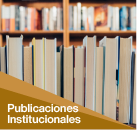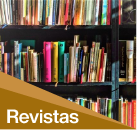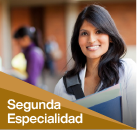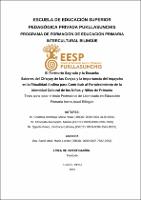El Territorio Sagrado y la Escuela: Saberes del Ch'uyay de las Ovejas y la Importancia del Inqaychu en la Ritualidad Andina para Contribuir al Fortalecimiento de la Identidad Cultural de los Niños y Niñas de Primaria
Fecha
2024-04-23Autor
Challhua Anchaya, Maria Rosa
Choccata Auccapiña, Marina
Qqenta Perez, Veronica Estefany
Nivel de Acceso
Acceso AbiertoMetadatos
Mostrar el registro completo del ítemResumen
Esta investigación tiene por finalidad proponer un material educativo sobre los saberes del ch’uyay de las ovejas y del inqaychu para contribuir al fortalecimiento de la identidad en estudiantes de primaria. La metodología es cualitativa y utiliza como principales instrumentos metodológicos la observación y la recogida de testimonios de los sabios. Los resultados mostraron que los sabios son fuente de conocimientos y experiencias, al ser los guardianes de las sabidurías del buen vivir. Además, durante la experiencia de aprendizaje que se desarrolló, los estudiantes fueron comprendiendo que las celebraciones están relacionadas con los espacios sagrados, en este caso con los Apus, inqaychu y pachamama, y reconociendo que las costumbres, tradiciones y saberes de su localidad forman parte fundamental de su identidad cultural. Esto les generó entusiasmo para querer seguir recogiendo y compartiendo estos saberes, conscientes de que algunos de sus saberes y costumbres se están perdiendo. Como futuras docentes en EIB consideramos que incorporar los saberes culturales en la enseñanza de los estudiantes es fundamental para que comprendan, conozcan, valoren y respeten las vivencias dentro de su territorio y puedan interactuar de manera armónica con otras culturas, construyendo la interculturalidad que tanto necesitamos para convivir. Abstract The purpose of this research is to propose educational material on the knowledge of sheep ch'uyay and inqaychu to contribute to the strengthening of identity in primary school students. The methodology is qualitative and uses observation and the collection of testimonies from wise men as the main methodological instruments. The results showed that the wise are a source of knowledge and experiences, being the guardians of the wisdom of good living. Furthermore, during the learning experience that was developed, the students began to understand that the celebrations are related to sacred spaces, in this case with the Apus, inqaychu and pachamama, and recognizing that the customs, traditions and knowledge of their locality are part fundamental of their cultural identity. This generated enthusiasm in them to want to continue collecting and sharing this knowledge, aware that some of their knowledge and customs are being lost. As future teachers at EIB, we consider that incorporating cultural knowledge in the teaching of students is essential so that they understand, know, value and respect the experiences within their territory and can interact harmoniously with other cultures, building the interculturality that we so need. to live together. Keywords: Bilingual Intercultural Education, ancestral knowledge, sacred territory, inqaychu, ch'uyay de las ovejas, cultural and ritual identity. Pısıy rımayllapı Kay llank’ay k’uskipaypa allpayninmi yawñapay huk llank’ana yachachinapaq uwiha ch’uyaypi yachaykunamanta, hinallataq inqaychuq allin kaqninmanta kay raymi ruraypi yachaywasi primaria nisqapi irqikunaq identidad cultural nisqa yanapanapaq. Metodologia nisqataqmi cualitativa nisqa, imaraykuchus qhawariy chaymantataq yachaqkunamanta testimonionisqa huñuy. allpaykunan niwanchis yachaqkunan kanku fuentenisqa imaymana yachaykunamanta riqsiyninkupi hinallataq yachayninkupipas, imaraykuchus paykuna kanku huk guardianisqa lliw yachaykunamanta allin kawsaypi ayllu uhupi tiyanapaq.iichaqa yachay wasi ukhupi yachaykuna mast’arisqamantapacha unancharinku, kay raymichaykunaqa hap’inasqa kachkanku kay espacios sagrados nisqakunawan (kay taqwiriypiqa kanman apukunawan, inqaychuwan hinallataq pachamamawan). Kaqllataqmi ari ninku kay ayllumpi raymichaykuna, kawsaykuna, yachaykuna hinallataq ñawpa ruraykuna sinchi allin identidad cultural nisqata kamanapaq. Hinallataqmi, kuraq awichukuna imaymana allin yachayniyuq kasqankuta riqsipanku; kaqllata kay wawakuna kachkanku anquyraywan yachaykunamanta t’aqwirimuyta qallarinankupaq, hinamantaq mast’arinankupaq. chaymantapas yuyayninkupin kachkanku yachaynin. Kay qhawarisqaykumanta pacha, qhipaman EIB nisqapi yacharichiqkuna hina, niykuman ñawpa awichanchiskunaq yachayninkuqa wawakunaq yachay atipayninkupi sinchi allinmi, yachaqkuna achwantaraq yachayninkupi atiparinankupaq; unanchanankupaq, riqsirinankupaq chaymantapas ayllunku uhupi chaninchanankupaq manchakuyniyuq kanankupaq , hinallataq allin kawsaypi kanampaq huk culturanisqakunawan, chay hinata kay interculturalidad nisqata kallpanchasunchik imaraykuchus ancha necesario nisqa allin kawsaypi tiyananchikpaq. Chanin rimaykuna: Educacion Intercultural Bilingue nisqa, ñawpa yachay, pachaq qapaqkaynin, uwiha ch’uyay, identidad cultural nisqa, chaympatapas ritual nisqa.







